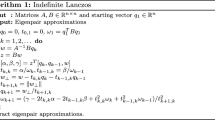Abstract
Riccati and Lyapunov equations can be solved using the recursive matrix sign method applied to symmetric matrices constructed from the corresponding Hamiltonian matrices. In this paper we derive an efficient systolic implementation of that algorithm where theLDL T andUDU T decompositions of those symmetric matrices are propagated. As a result the solution of a class of Riccati and Lyapunov equations can be obtained inO(n) time steps on a bidimensional (triangular) grid ofO(n 2) processors, leading to an optimal speedup.
Similar content being viewed by others
References
[A] B. D. O. Anderson, Second-order convergent algorithms for the steady-state Riccati equation,Internat. J. Control,28 (1978), 295–306.
[B1] A. Y. Barraud, Investigations autour de la fonction signe d'une matrice. Application a l'équation de Riccati,RAIRO Automat.,13 (1979), 335–368.
[BS] R. Bartels and G. Stewart, Solution of the matrix equationAX+XB=C, Comm. ACM,15 (1972), 820–826.
[B2] J. Bognar,Indefinite Inner Product Spaces, Springer-Verlag, New York, 1974.
[BBVH] A. Bojanczyk, R. Brent, P. Van Dooren, and F. de Hoog, Downdating the Cholesky factorization,SIAM J. Sci. Statist. Comput.,8 (1987), 210–221.
[BL] R. P. Brent and F. T. Luk, Computing the Cholesky Factorization Using a Systolic Architecture, Report TR-CS-82-08, Department of Computer Science, Australian National University, 1982; alsoAustral. Comput. Sci. Commun.,5 (1983), 295–302.
[BP] J. R. Bunch, and B. N. Parlett, Direct methods for solving symmetric indefinite systems of linear equations,SIAM J. Numer. Anal.,8 (1971), 639–655.
[B3] R. Byers, Hamiltonian and Symplectic Algorithms for the Algebraic Riccati Equation Ph.D. thesis, Cornell University, Ithaca, NY, 1983.
[B4] R. Byers, Solving the algebraic Riccati equation with the matrix sign function,Linear Algebra Appl.,85 (1987), 267–279.
[DS] J. J. Dongarra and D. C. Sorensen, Linear algebra on high performance computers,Appl. Math. Comput.,20 (1986), 57–88.
[GL] J. Gardiner and A. Laub, A generalization of the matrix-sign-function solution for algebraic Riccati equations,Internat. J. Control,44 (1986), 823–832.
[GS] G. H. Golub and M. A. Saunders, Linear least squares and quadratic programming, inInteger and Nonlinear Programming II (J. Abadie ed.), pp. 229–256, North Holland, Amsterdam, 1970.
[GV] G. H. Golub and C. F. Van Loan,Matrix Computations, North Oxford Academic, Oxford, 1983.
[H1] S. Hammarling, Numerical solution of the stable non-negative definite Lyapunov equation,IMA J. Numer. Anal.,2 (1982), 303–323.
[H2] N. J. Higham, Newton's method for the matrix square root,Math. Comp.,46 (1986) 537–549.
[HB] K. Hwang and F. A. Briggs,Computer Architecture and Parallel Processing, McGraw-Hill, New York, 1984.
[K] H. T. Kung, Why systolic architectures?IEEE Trans. Comput.,15 (1983), 37–46.
[KL] H. T. Kung and C. E. Leiserson, Algorithms for VLSI processor arrays, inIntroduction to VLSI Systems (C. Mead and L. Conway, eds.), pp. 271–292, Addison-Wesley, Reading, MA, 1980.
[L1] A. Laub, A Schur method for solving the algebraic Riccati equation,IEEE Trans. Automat. Control,24 (1979), 913–921.
[L2] A. Laub, Schur techniques in invariant embedding methods for solving two-point boundary value problems,Proceedings of the 21 st IEEE Conference on Decision and Control, Orlando, Florida, 1982, pp. 56–61.
[LH] C. L. Lawson and R. J. Hanson,Solving Least Squares Problems, Prentice-Hall, Englewood Cliffs, NJ, 1974.
[L3] F. T. Luk, A triangular processor array for computing singular values,Linear Algebra Appl.,77 (1986), 259–273.
[L4] F. T. Luk, Architectures for computing eigenvalues and SVDs, inHighly Parallel Signal Processing Architectures, pp. 24–33, Proceedings of the Society of Photo-optical Instrumentation Engineers, Vol. 614, 1986.
[OS] D. P. O'Leary and G. W. Stewart, Data-flow algorithms for parallel matrix computations,Comm. ACM,28 (1985), 840–853.
[PV] C. C. Paige and C. Van Loan, A Schur decomposition for Hamiltonian matrices,Linear Algebra Appl.,41 (1981), 11–32.
[PLS] T. Pappas, A. Laub, and N. Sandell, On the discrete-time algebraic Riccati equation,IEEE Trans. Automat. Control,25 (1980), 631–641.
[U] F. Uhlig, Inertia and eigenvalue relations between symmetrized and symmetrizing matrices for the real and the general field case,Linear Algebra Appl.,35 (1981), 203–226.
[V] P. Van Dooren, A generalized eigenvalue approach for solving Riccati equations,SIAM J. Sci. Statist. Comput.,2 (1981), 121–135.
[W] J. H. Wilkinson,The Algebraic Eigenvalue Problem, Clarendon Press, Oxford, 1965.
Author information
Authors and Affiliations
Rights and permissions
About this article
Cite this article
Charlier, J.P., Van Dooren, P. A systolic algorithm for riccati and lyapunov equations. Math. Control Signal Systems 2, 109–136 (1989). https://doi.org/10.1007/BF02551818
Received:
Revised:
Issue Date:
DOI: https://doi.org/10.1007/BF02551818




